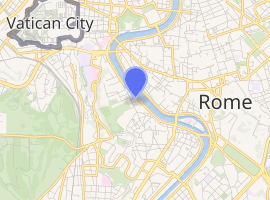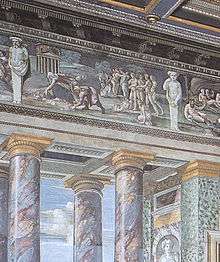Villa Farnesina
The Villa Farnesina is a Renaissance suburban villa in the Via della Lungara, in the district of Trastevere in Rome, central Italy.
| Villa Farnesina | |
|---|---|
.jpg) Villa Farnesina in Trastevere | |

| |
| General information | |
| Town or city | Rome, Trastevere |
| Country | Italy |
| Coordinates | 41.893611°N 12.4675°E |
| Construction started | 1506 |
| Completed | 1510 |
| Client | Agostino Chigi |

Description
The villa was built for Agostino Chigi, a rich Sienese banker and the treasurer of Pope Julius II. Between 1506–1510, the Sienese artist and pupil of Bramante, Baldassare Peruzzi, aided perhaps by Giuliano da Sangallo, designed and erected the villa. The novelty of this suburban villa design can be discerned from its differences from that of a typical urban palazzo (palace). Renaissance palaces typically faced onto a street and were decorated versions of defensive castles: rectangular blocks with rusticated ground floors and enclosing a courtyard. This villa, intended to be an airy summer pavilion, presented a side towards the street and was given a U-shaped plan with a five-bay loggia between the arms. In the original arrangement, the main entrance was through the north facing loggia which was open.[1] Today, visitors enter on the south side and the loggia is glazed.
Chigi also commissioned the fresco decoration of the villa by artists such as Raphael, Sebastiano del Piombo, Giulio Romano, and Il Sodoma. The themes were inspired by the Stanze of the poet Angelo Poliziano, a key member of the circle of Lorenzo de Medici. Best known are Raphael's frescoes on the ground floor; in the loggia depicting the classical and secular myths of Cupid and Psyche, and The Triumph of Galatea. This, one of his few purely secular paintings, shows the near-naked nymph on a shell-shaped chariot amid frolicking attendants and is reminiscent of Botticelli's The Birth of Venus. This same "Galatea" loggia has a horoscope vault that displays the positions of the planets around the zodiac on the patron's birth date, 29 November 1466. The two main ceiling panels of the vault give his precise time of birth, 9:30 pm on that date.[2]
At first floor level, Peruzzi painted the main salone with trompe-l'œil frescoes of a grand open loggia with an illusory city and countryside view beyond. The perspective of the painted balcony and colonnade is very accurate from a fixed point in the room.[3] In the adjoining bedroom, Sodoma painted scenes from the life of Alexander the Great, the marriage of Alexander and Roxana, and Alexander receives the family of Darius.
The villa became the property of the Farnese family in 1577 (hence the name of Farnesina). Also in the 16th century, Michelangelo proposed linking the Palazzo Farnese on the other side of the River Tiber, where he was working, to the Villa Farnesina with a private bridge. This was initiated, remnants of a few arches are in fact still visible in the back of Palazzo Farnese towards via Giulia on the other side of the Tiber, but was never completed.
Later the villa belonged to the Bourbons of Naples and in 1861 to the Spanish Ambassador in Rome, Bermudez de Castro, Duke of Ripalta. Today, owned by the Italian State, it accommodates the Accademia dei Lincei, a long-standing and renowned Roman academy of sciences. Until 2007 it also housed the Gabinetto dei Disegni e delle Stampe (Department of Drawings and Prints) of the Istituto Nazionale per la Grafica, Roma.
The main rooms of the villa, including the Loggia, are open to visitors.[4]
See also
References
- Coffin David, The Villa in the Life of Renaissance Rome, Princeton University Press 1979, p. 91
- Quinlan-McGrath, Mary (1984). "The Astrological Vault of the Villa Farnesina: Agostino Chigi's Rising Sign". Journal of the Warburg and Courtauld Institutes. 47: 91–105. doi:10.2307/751440. JSTOR 751440.
- Decker, Heinrich (1969) [1967]. The Renaissance in Italy: Architecture • Sculpture • Frescoes. New York: The Viking Press. p. 286.
- Archived June 22, 2006, at the Wayback Machine
- Murray, Peter (1963). The Architecture of the Italian Renaissance. New York: Schocken Books. pp. 151–153.
External links
Images
| Wikimedia Commons has media related to Villa Farnesina (Rome). |
- Loggia di Psiche by Raphael
- Street Facade and Frescoes
- Garden Facade
- Architecture
- Satellite photo — The bracket-shaped building southwest (lower) of the Tiber, in the centre of photo, is the Villa Farnesina. The Palazzo Farnese is the massive almost square, courtyarded structure to the North of the Tiber.
- Virtual tour of Villa Farnesina on romainteractive.com